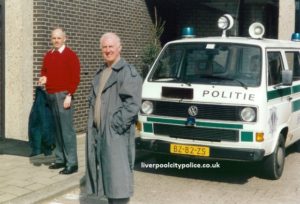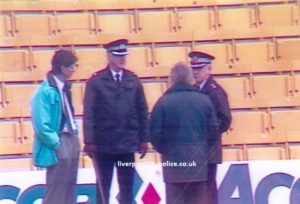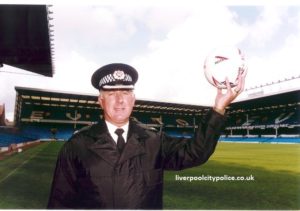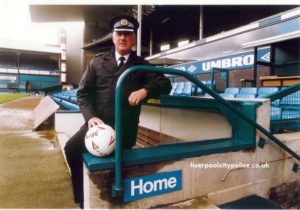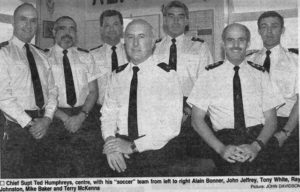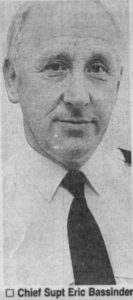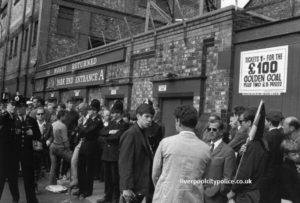FOOTBALL UNIT by ted humphries, retired
Policing Professional Football in Liverpool
In early 1993 I was a Detective Superintendent at Lower Lane Police Station in command of the Divisional Detective Offices at Walton Lane, Lower Lane and Kirkby. Throughout my previous career I had interchanged between the uniform and detective branches on a regular basis and whilst in uniform I had been involved with policing at Everton and Liverpool from my days as a Probationary Constable in 1962 until my tour with the Operational Support Division in 1982.
As a Probationary Constable I had the opportunity to volunteer to attend Saturday games in uniform whilst on rest from night duty and evening games from morning duty or before going on night duty. I had to make my own way to the stadium suitably attired in helmet, great coat or/and cape, white woollen gloves, and baton. No handcuffs, gas spray, knife vest, mobile telephone or even radio in those days I was fortunate to be selected to patrol around the pitch side at most matches so I could enjoy the atmosphere within the ground as well as watching part of the game. Football violence was very limited in those days and I never had occasion to arrest anyone in the stadiums at Everton and Liverpool or to eject anyone. Those former officers who worked at the two grounds at that time will remember ‘Mr Football’ – Sergeant 8 ‘E’ Jim Hesketh. An ex Guardsman Jim cut a dashing figure. Some 6′ 4″ in height and very smart he was the fulcrum on match days operating on pitch duty with a cool head. A real leader
In 1966 England hosted the World Cup and Goodison Park was selected as one of the host grounds. Again I was on pitch duty and saw such great players as Puskas, Eusabio and the like in thrilling games to packed stadiums. A carnival atmosphere was not marred by trouble and was enjoyed by all who attended.
Liverpool Football Club had won the league in 1963 and 1965 and were emerging as a force to be reckoned with on the football stage. They set about making ground improvements to their stadium and during the same period football violence as we know it was becoming a factor and affecting stadiums up and down the country. At first the violence was limited to groups of young home ‘fans’ making concerted attacks on opposing supporters and Policing of football moved to keep pace with the changing times.
The violence at first was on the approaches or at departure points from stadiums but insidiously crept to within the stadiums themselves This had a detrimental effect, driving away the family fans of women and children to mainly all male crowds.
In the 1970s I was a Sergeant in charge of 10 Constables with the Tactical Patrol Unit of ‘B’ Division stationed at Copy Lane. We represented the Division at all first team football matches at the two grounds and I immediately saw the difference to the policing I had witnessed in the 1960s. I took part in several baton charges along Walton Lane, Priory Road, Walton Breck Road and attended serious disturbances at public houses in the area of the grounds. Coaches of away fans were being attacked and had to be escorted as did those fans walking the long walk from Lime Street Railway Station. Police dogs were now deployed to help with the violence and the mounted department were pro-active in crowd trouble not just controlling queues. Liverpool were now in Europe and fans from all across Europe attended many great evenings at the stadium over the next few years.
Derby Matches between the two local clubs always had the potential for highly charged atmospheres and could on occasion boil over in to limited fighting on the terraces which was quickly dealt with. With the increasing success of Manchester United games between them and Liverpool were always high-risk games and violence could erupt at any time. Our resources could be stretched and seriously tested with little post match publicity.
I think it is fair to say that at this time the Police (wrongly in my opinion) accepted some responsibility for crowd safety which was to be a major issue later at Hillsborough. The disaster in Glasgow at Ibrox in 1971 when 66 people died was a foretaste of disasters to come.
From Copy Lane I moved to the Operational Support Division post 1981 riots and Public Order Training had become a priority within the countries Police Forces. Football hooliganism had become more sophisticated in its organisation with pre-arranged agreed venues for battles between supporters and the Police were developing their own intelligence systems and methods of policing to cope with this ever increasing problem.
From the Operational Support Division I moved to Eaton Road as Inspector and returned to the Detective Branch a year later as Detective Inspector at Lower Lane. I was involved with football again acting in official capacity as Intelligence Liaison at all home games when on duty. After two further promotions I became Detective Superintendent at Lower Lane.
After some time at Lower Lane I was approached by the uniform branch with the request that I consider a move back to the department to take up the post as Deputy to Chief Superintendent Eric Bassinder who not only commanded the Division but was responsible for policing at Everton and Liverpool. I subsequently made the move and was duly trained ‘in-house’ over a 3 month period also attending the Major Disaster Course at Bramshill Police Collage. This was essential training for I was to take over as Chief Superintendent on the retirement of Eric Bassinder a short while later.
I took up the role of Gold Commander with the history of the disasters at Bradford Football Ground, Hillsborough Football Ground, and Heysal Football Ground still fresh in my mind. A dedicated Football Unit was in place at Lower Lane staffed by very professional Officers who carried out daily liaison with both clubs and we enjoyed a very good working relationship with them. Intelligence was very much to the fore and we employed spotters at all home grounds and away games together with video cameras with spotters high up in the stadiums.
I went to Holland to view their policing of football violence and during my time there attended the local derby between Feyenoord Football Club and Ajax Football Club. The violence I witnessed at close hand that day in and around the stadium is the worst I have ever seen and the Dutch Police were stretched to the limit to try and control it. Extensive damage was done to the stadium but fortunately there were no fatalities.
The key role within the Football Unit was that of the Match Inspector who had a day to day hands on role with responsibility to the Chief Inspector for planning and executing operational orders on the day.
For many years the Liverpool Force had a mutual aide policy in place within the force whereby each Division supplied personnel and vehicles on match days to support the Football Unit. This could be increased or decreased depending on the perceived threat to public disorder.
Of course not all disasters occur as a result of football violence eg Bradford Fire and in my time as Commander a very serious situation arose at the last home game of the 1993/1994 season when Everton were at home to Wimbledon. Everton had to win to stay in the Premier League. Supporters arrived at the ground from all over the world, unfortunately many of them far too late. A common problem on normal match day but aggravated by sheer numbers on this occasion. Whilst on a routine patrol outside the ground I arrived at Gwladys Street on a circuit of the stadium and found that the street was totally blocked with people to the point where no one could enter or leave the crowd as they were compressed so tightly together. Clearly a serious situation had developed with very real danger to Police Officers and civilians in the street. At this stage no information had been received as to how serious the situation was so it must have happened quite suddenly. Fortunately we communicated the situation quickly to the Control Room and the Club and loudspeaker announcements led to the outer edges of the crowd moving in to Bullens Road easing the crush and preventing serious injury.
Throughout my time as Gold Commander I adopted the stance that we were responsible for public order and the clubs accepted that they were responsible for the safety of the public. At that time Human Rights Legislation and Health and Safety Directives were not at the forefront as they are today.
Ted Humphreys,
Retired Chief Superintendent,
Merseyside Police


